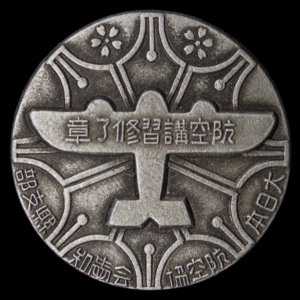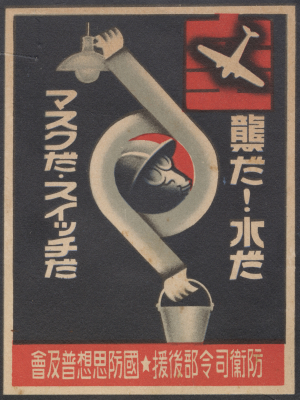Margo Lakin, Trinity Communications

“This is the photo that launched a thousand ships — and the book,” Gennifer Weisenfeld shares as she taps the front cover of her latest publication, “Gas Mask Nation: Visualizing Civil Air Defense in Wartime Japan.”
The book’s cover photo, “Gas Mask Parade, Tokyo (Gasu Masuku Kōshin, Tōkyō),” was taken in 1936 by the modernist Japanese photographer Horino Masao. His black-and-white image captures a never-ending procession of schoolgirls, dressed in a standard uniform of white long-sleeve shirt and dark jumper, as they march in unison through the popular and fashionable Ginza district in Tokyo.
The uniformity repeats in the provocative choice of headwear: a gas mask, with large eyeholes and fitted with a bulbous breathing filter. The expressionless girls pass by onlookers in anonymity, like a parade of aliens from a 1950s science fiction movie.

Weisenfeld, professor and director of graduate studies of the Ph.D. in Art History in the Department of Art, Art History and Visual Studies (AAHVS), has long followed Horino’s work. She had just finished work on her book “Imaging Disaster,” that focused on the Great Kantō earthquake in 1923, when his gas mask parade specifically piqued her curiosity.
“Looking at the subject matter raised a lot of questions in my mind,” she says. “I just needed to know what was going on — and I tend to be drawn to dark topics,” she confesses.
“My previous book dealt with visual responses to the massive devastation of the 1923 earthquake and how to imagine a more resilient city, so transitioning to how Japan mobilized for possible destruction in war felt like the next logical chapter.”
And so began her decade-long research to explore how the Japanese government, along with many businesses, utilized rich and creative marketing campaigns to sell, engage and prepare the public for the possibility of war from the air.
In her research, she found the expected patriotic posters illustrating how model citizens should prepare their homes and bodies and the propaganda pieces warning of the horrors that could come if lights weren’t properly blackened out during an air raid.
But she also discovered a collection of imagery, some humorous, that went far beyond the usual wartime fare of posters and patriotic songs — and their volume was staggering.
“I was floored by the depth of the materials and the creative investment,” she says. “It was so much richer than I previously thought.”

There were magazines sporting covers designed by established artists, ornate badges and medals awarded to citizens who successfully completed air defense courses, popular candies sold with paper gas mask kits as free giveaways for children, department store window displays, kimonos and tote bags decorated with images of battleships and airplanes — and even a theme park where visitors could take part in a parachute jump.
“What the Japanese air defense movement achieved was truly a saturation of all the senses meant to permeate mass culture,” she explains.
But why did the small nation of Japan invest time and talent to produce such a magnitude of materials?
Weisenfeld explains that when Japan invaded Manchuria in 1931, it began the country’s Fifteen-Year War and triggered an awareness for civil and military defense. Because Japan is a small archipelago, and at the time cities were built from wood, there was a constant threat from incendiary bombs.
“The government feared the real possibility of not only losing a war but also its population, so it conceived of a campaign to keep the citizens engaged in a collective spirit focused on preparing themselves for war,” she explains.
In her book, Weisenfeld focuses on three symbolic components of war: the gas mask, the airplane and the bomb. She was inspired by an advertisement for a gas mask company where motifs of the three were used.
“During my research, I noticed a consistency in vocabulary and imagery bubbling to the surface around these three objects,” she explains. “Although they were intertwined, I felt that each deserved a chapter.”
She ends the book discussing how the gas mask, once used to unite citizens in civil defense, has been embraced by the postwar, counterculture movement. It has become the modus operandi for protesters seeking anonymity.

“It’s now also a symbol of industrialization and environmental toxicity — and fetish,” she says.
Returning to the intriguing and provocative cover photo, Weisenfeld explains, “This image of young girls in gas masks serves two purposes.
“First, we see the nation’s obvious fear of war by using the gas mask as a symbol of alarm and anxiety. But we also see a developing fear of the modern female. For this example, the gas mask is a symbol of grotesque pleasure. The imagery is designed to be titillating, so we have these alure/alarm and threat/thrill effects.”
Weisenfeld hopes the book provides readers with a deeper appreciation of the complexities of war culture and the ways it engages the public, while encouraging them to rethink the 15 years Japan was at war.
“I’d like for people to understand that the Japanese citizens weren’t merely suppressed but why they so enthusiastically engaged in war. Wartime was a complex mix of pain and pleasure,” she says.
“And I’d like us to question why we continue to engage in war.”
The Nasher Museum of Art will host an author talk and book signing on March 9 from 6:00-8:00 P.M., where Weisenfeld will be joined by Paul B. Jaskot, professor and chair of AAHVS, for a discussion.
“Gennifer’s book has made a real contribution to the study of modern art history at Duke,” Jaskot says.
“The book is especially impressive in how it weaves together important areas of modernist visual culture — particularly photography — with the social history of Japan during the war years. I expect it to make a big impact on the study of art and war in general and on modern interwar-era studies in specific.”
